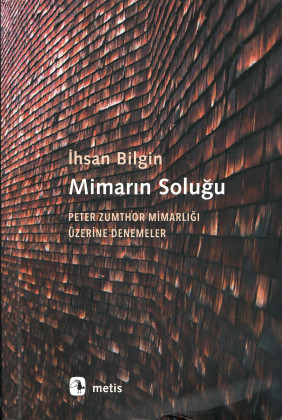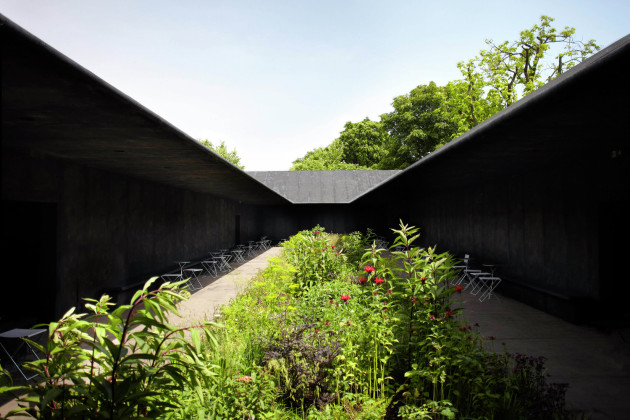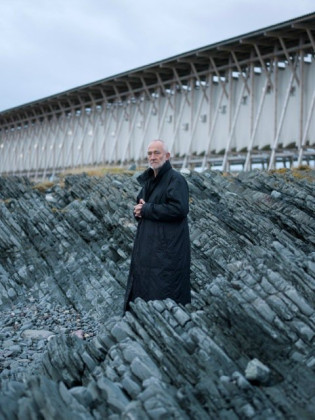Peter Zumthor and the Minor Architecture
-to the damn feds-
The objects we perceive have no message for us, they are simply there. [...] They reach beyond signs and symbols, they are open, empty. It is as if we could see something on which we cannot focus our consciousness. Here, in this perceptual vacuum, a memory may surface, a memory which seems to issue from the depths of time. Now, our observation of the object embraces a presentiment of the world in all its wholeness, because there is nothing that cannot be understood. (Zumthor, “Thinking Architecture” 17)
John Cage said in one of his lectures that he is not a composer who hears music in his mind and then attempts to write it down. He has another way of operating. He works out concepts and structures and then has them performed to find out how they sound. (Zumthor, “Thinking Architecture” 29)
Just as it was foretold that the 21st century would be “the century of Deleuze” in ways of thinking, are we now or will we soon be in “the century of Zumthor” in architecture and design?
A book in Turkish was recently published about the world-renowned architect Peter Zumthor (Feb. 2016, Metis). I devoured the book, and so did my students. We discussed it during my lectures…
I hope the book, written by İhsan Bilgin and including a long “homage” list, will inspire the students’ interest in both the author’s delicious intellectual texts and Zumthor’s works and books. Academic literature on architecture generally covers bland texts, written as if they are to be read by sculptures rather than human beings. That’s probably why reading these texts make us feel like we are in court; almost as if justice may or may not be served at the end of the text. In contrast, Bilgin’s texts are like springs of water in the ground. I will attempt in this article to start off from Bilgin’s composition and proceed towards Zumthor’s books.
Let’s take Bilgin’s book as a kind of “intro”; critical works may follow that take more systematic (discussing the problematic aspects of his works by historicizing them) and extensive (evaluating all his projects and contemporary productions) approaches. Mimarın Soluğu (The Architect’s Breath), however, is far from being systematic or comprehensive: excluding the up-to-date introductory chapter (“Why Zumthor?”—a chapter that is not actually an update for Zumthor, and rather limited to the Bilgin’s own catching up), all the remaining texts, in the order they appear, were published in: 2009 (YeniMimar), 2001 (Arredamento), 2009 (Betonart) and 1999 (XXI ve Defter).
Mimarın Soluğu is the kind of book title that deeply embraces the design philosophy of Zumthor, expressing the hesitation nested in the breath of metaphysics and material dimensions. While on one hand it hints at the designer’s attempt to directly connect to the material and the problem/task; on the other it draws on the designer’s proximity to the human body and sensuality that experiences the building. Bilgin defines this self-professed mission of the designer as “embracing the way of reaching the spirit through the material” (Bilgin 103).
Bilgin touches upon Zumthor’s principal works. (The architect’s studio, Saint Benedict Chapel, the Gugalun House are the small scale projects. Kunsthaus Bregenz is a singular urban construction. Chur Archaeology Museum and the Kolumba Museum are medium-sized projects. Spittelhof units are a small scale housing estate project. Topography of Terror and EXPO Swiss Pavilion are major urban installations. The Therme Vals is an extension building, and without a doubt, a magnum opus.) Yet the book lacks a series of recent era productions of the designer such as the Steilneset Memorial, The Temporary Exhibition House in Switzerland, the Los Angeles County Museum of Art project in California, the renovation of a flour factory in Leiden and the 2011 Serpentine Pavilion. This deficiency can be solved by including Zumthor’s up-to-date biography in the book’s next edition.
These unmentioned buildings go beyond constituting only a physical absence; they weaken the image of the architect, as well as the book’s main arguments on him. This comes from Zumthor’s change in behavior that resembles the Bilboa style icon-worship that he had previously criticized; the architect expanded his team, familiarized with contemporary practices, and designed the master plan through highly conventional urban decisions. Zumthor perhaps doesn’t design a new building for the project, as Gehry does—if you don’t take what he does by leaving buildings as only structures, redesigning their facades all over again, and adding transparent layers with lights as a brand new design. He creates two clear areas by demolishing certain buildings, proposes new canals and pedestrian bridges; he integrates the axis of two large urban parks that vertically cut the project site with the preserved industrial site, and he takes the responsibility of designing the parks.
Looking at the bigger picture, he embraces a “common” urban decision developed by a different initiative to provide a circular continuity of green spaces inside the castle, and blends it into his own site. It is the epitome of disappointment to see in his urban program for the Flour Factory a realization of the gentrification, museumification, commercialization and elitization agendas that occur in so many other examples around the world. A cafe, a shop, a restaurant, student housings, studios, a hotel, a museum, luxurious residences... You can find everything in there but radicalism. What is assigning functions like hotels, design centers and residences to existing industrial buildings he had decided to preserve right before peeling off their facades, if not setting the threshold of elite reproduction of the neo-liberal market understanding? It is as if the radical Zumthor in Therme Vals project evaporated in the Leiden project. Zumthor speaks professionally in the conference video recorded during an English presentation of his project. His panels in German however are dominated by his activist and sharp identity; he is more authentic.
Zumthor Image
Is “the way” of Zumthor really rejecting stardom and icon-worshiping architecture? Awards don’t always go to stars; but he did not reject the RIBA or the Pritzker (there are people who turned down the Nobel Prize). At this point, he is really not a saint. He may have shown us “another way of stardom”; perhaps this different path is, although not brand new, a way of modestly joining with the low-key and earnest “author” architect/ artist/writer persona.
The Zumthor image presented by Bilgin is in harmony with the architect’s dimly-lit buildings. Despite avoiding Zumthor’s commercial and cliché image in the global architectural market, Bilgin doesn’t take long to create his own image of the architect. He defines Zumthor, born in Basel, Switzerland in 1943, as an architect who “creates closed worlds like Monad” and “produces works that cannot be interrupted” (Bilgin 33). As the book proceeds, Zumthor’s image gains different dimensions and transforms into a sharper character: He is the architect who never leaves his spot, who will not increase his capacity, who will not change: he avoids the influence of the global scene and its innovations, he doesn’t indulge in current events, and he doesn’t attempt to change the world. Zumthor fortified his inner world as a castle (Bilgin 36-7). As it appears, though, this image is already being eroded.
In order to make away with some of these labels, it is better to look at the architect’s work through a “working style/ ars poetica” dimension rather than focusing on “his impact/aura”; and this may create a more playful, joyous image of Zumthor. Associating the architect’s own person with his designs misses the mark; just as it does when you take the novelist to be the character. The image of Zumthor as the satyr of the wilderness of Alps, or some other image… The Therme Vals book is a good source for this: the book opens up a detailed account of the modus operandi of the work that avoids the audience-oriented simplicity of the conference texts. Manufacturing with images, fluctuations that come and go between process and conclusion, and fractures unroll modestly in the book. There is no spiritual image of Zumthor; and I will return to this point later on. Zumthor’s “uniqueness” seems to come from his method of creating, determining and employing his time to work. The architect appears to have a operating rhythm that falls outside the speed mania by avoiding the classical rhythms of project deadlines, and expanding the work over large periods of time. Bilgin describes this temporality as:
…if [the designer] directs his attention to the situation itself, takes his inspiration from the uniqueness of the situation; if he knows how to pay attention every time the sun rises, to every section of the tree, to the state of people every night; if he is open to look, hear, smell, taste and touch, and has refused to automatize these processes, if he is aware that there is nothing or no moment repeating itself after once unraveling its specific conditions, then his claim is in producing within that openness. (Bilgin 43)
Bilgin defines the current against which Zumthor is fighting as “an out-of-control tendency to nominalize,” (38). In an age of icons where everyone wants to be known by their own names (post-1980s), Zumthor exposes the global market where cities, transformed into geographies of names, fall into a wave of neo-anonymity; and those who start off from uniqueness and originality only end up in ordinariness. The 1980s, according to Bilgin, was when this peculiarity transformed into an industry; making what used to be the take-off point the end-result destination.
In “The Density of Matter”, Bilgin step-by-step discovers aspects of Zumthor’s minor architecture: “the impossibility of predicting the past or future works by looking at one of them” (Bilgin 47) is one them; the architectural version of that unique situation which Deleuze and Guattari described as an “alienation from your own language” in their debates on minor literature. (I will not, however, attempt to look at Zumthor’s works through the framework of Deleuze and Guattari’s conceptualization of minor literature; no matter how appealing that sounds, it can be topic of another article.)
One step further, Bilgin writes of, “the material and the condition as fermented and refined intensities that draw all towards them, and accept their responsibility” (Bilgin 48). Later on, he writes:
[Zumthor] does not judge after the encounter, but invests in the encounter itself. He doesn’t have any tendency to repeat, to collect, or to reproduce. He appears, leaves a mark and vanishes. It is required every time to start over and experience all again. (Bilgin 53)
Bilgin writes of the Bregenz Exhibition House:
Sliding from things as meaning to things as direct experience. This is a search to withdraw to the experience to a place before the semiotics appear; where meaning is excluded by short-circuiting experiences through the intermediation of conventions. (Bilgin 60)
If it is not essentialism, it is certainly a step towards minor architecture. Zumthor, the architect “most prepared to face the direct version of the situation, and the phenomenon” (Bilgin 75-9), suspends the priority of the subject by stating, “the ideas are only in the objects and there is no other idea outside them.” That last sentence is from Zumthor’s Thinking Architecture.
To be continued…
Notes:
www.youtube.com/watch?v=N4QsGTZJwuA. Last date of access: 24. 3. 2016, 23:12
Works cited
-Bilgin, İhsan. The Architect's Breath: Essays on the Architecture of Peter Zumthor. İstanbul: Metis, 2016.
-Zumthor, Peter. Thinking Architecture. Trans. Maureen Oberli-Turner. Basel: Birkhauser, 2006.
-Zumthor, Peter. Atmospheres. Basel: Birkhauser, 2006.
Related Content:
-
Dynamic Intervals within the Static
If I have to summarize the biennale in one word, it would be “foggy”. And the main reason of the fogginess is the theme itself.
-

Modest Structures: Zumthor’s Allmannajuvet Zinc Mine Museum
-
Random Thougths
The Archdeacon’s monologue, occurring in 1482, that at first glance can be read as description of the Church’s founding dogmas and hegemony’s erosion
-

Multiplying by Repetition
-
A Poem to the Poor
Architecture is has been questioning, and subsequently redefining its own social position and social role for almost a century now
 29.04.2016
29.04.2016











